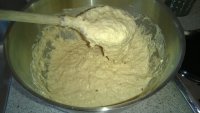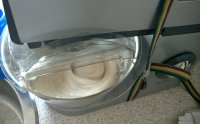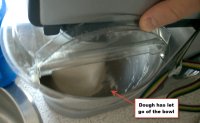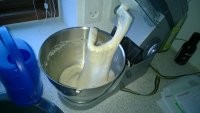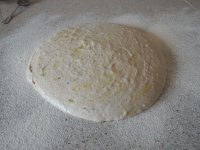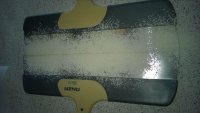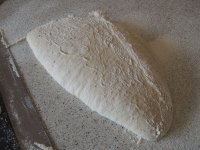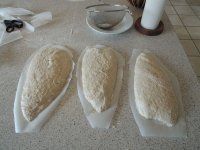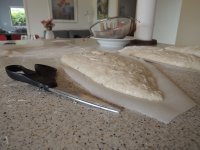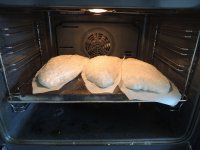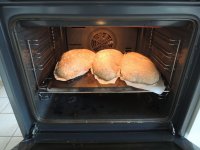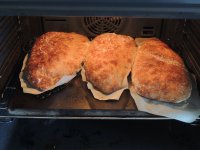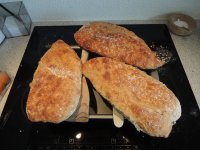Fluffy bread with large holes
After 15 years of training, reading, trying techniques, asking my neighbor who is an educated baker, watching TV-shows, structured "Design of experiments", etc, etc, I finally succeded!!! Yummy!
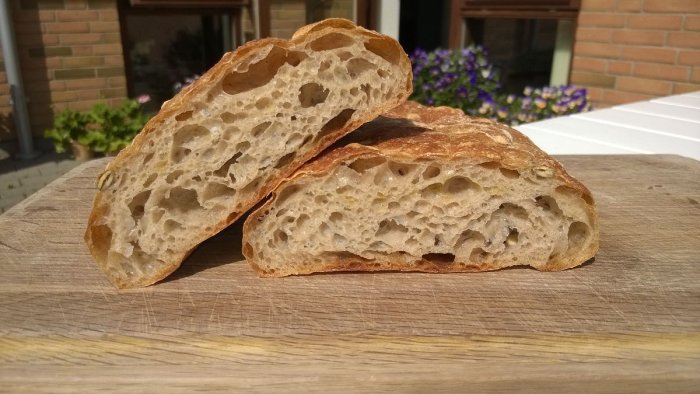
Success factors
Succeding with this bread depends on the following four factors.
- The right flour.
- Access to the essential tools.
- The right recipe.
- Sufficient experience with the process.
The right flour
Flour is not just flour and you will most likely not find the right flour in the first attempts. The main factor is the flour's ability to contain water. Cheap flour from your local discount supermarket will most likely not be able to hold enough water. Baking with such flour will result in rather stiff bread as you need to add a lot more flour.
Basically you need two types of flour.
- Milled white wheat flour - this is approximately 60-75% of the bread and is what ensures a non-flat bread. For several years, I believed that high quality stone-grained whole wheat flour was the key ingredient, but it isn't!
- Stone-grained whole grain wheat flour - this is around 25-40% of the bread and the type of this determines the taste and roughness of the bread.
As mentioned, flour is not just flour. I buy mine in a high-end Danish supermarket (Brugsen) from Claus Meyer (famous Danish cook) at around 2£ / 4$ per kilo. You probably can't get this flour outside of Denmark, so I will give some general directions instead. In case you live in New York, you MAY be able to get it (or something equally good) by visiting the Great Northern Food Hall at Grand Central Station.
- Price equals quality - take the low price flour from a discount supermarket. Multiply the kilo-price by 8-12 and you have a rough idea of the price you need to pay to get some decent flour.
- Check your local high-end supermarket - it may have what you need. Alternatively, you probably need to go to a health shop.
- Buy organic - it costs but taste and baking-ability is often higher.
- Test your flour - see below.
A colleague of mine told me that the harvesting time of the wheat plays a tremendeous role (his brother was an organic farmer). Just a few days of unfortunate rain around harvesting time can significantly reduce the wheat's baking-ability. Thus, the quality of the flour is clearly the largest uncontrollable factor in bread-making, and you can't see the quality from the flour. :-/
Essential tools
In my view you cannot bake breads like this without the following essential tools (listed in the order you use them): Please support my site and buy through my affiliate links below - it won't cost you extra.
- Tough mixer that can take 2kg of dough for 30 minutes without a meltdown. In Denmark, these costs around 250£ / 4-500$ for the cheapest one. Forget about kneading the dough in hand unless your torso matches Arnold Schwarzenegger around his early eighties period :-)
I have a Kenwood, but other brands like KitchenAid
will also get the job done.
- Silicone Rubber Baking Spatula
for taking the dough out of the bowl.
- Fine mesh strainer
for spreading a thin layer of flour on the table.
- Two wide dough spatulas for cutting and lifting the wet dough. Mine are from the local hardware store and are actually for scraping walls :-)
- Thin pizza shovel
, preferrably made of metal.
- Thick lava-stone - mine is about 2cm thick and takes 45 minutes to heat. I couldn't find a good one on Amazon - probably because they are quite heavy :-).
- A small baking brush
to dust off excess flour after baking.
I think the price for this adds up to about 400£ or 8-900$, which is quite an investment.
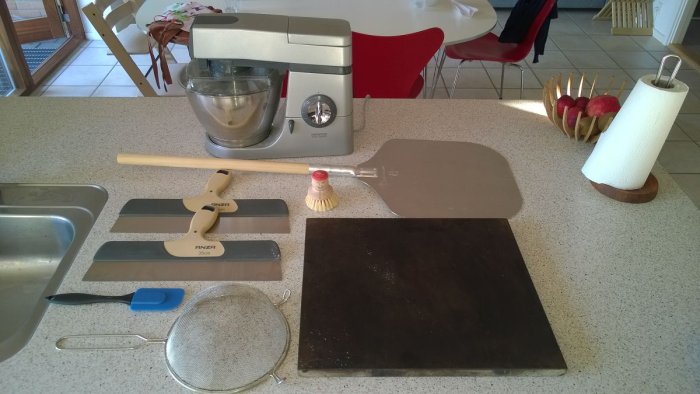
Recipe
| Ingredient | Amount |
|---|---|
| Cold water | 5 dl |
| Yeast | 5 g |
| Salt | 12 g |
| White wheat flour | 350-400 g |
| Whole-grain wheat flour | 150 g |
Process
Despite of a simple recipe, this bread is actually rather difficult to make as there are many uncertainties involved of which the largest is by far the flour. The second largest uncertainty is the steps in the process, where there are a several crucial points. The overall feeling through the process is... This will never be bread!!
Mistakes and misbeliefs during those 15 years of experimentation
- Impatience when kneading - this is clearly where I wasted most time. Watching the mixer for a couple of minutes or five where absolutely nothing happens made me add a bit of flour then another bit and so on.
- Rough bread is made from roughly grinded whole-wheat flour - NOPE!!! It is made from 60-75% white wheat flour and 25-40% roughly grinded special wheat flour.
- Not following the recipe to the point - I actually had the recipe for a long time, but I relied too much on my many years of "experience".
- Not using the right flour - there can be a tremendous difference between types of flour.
